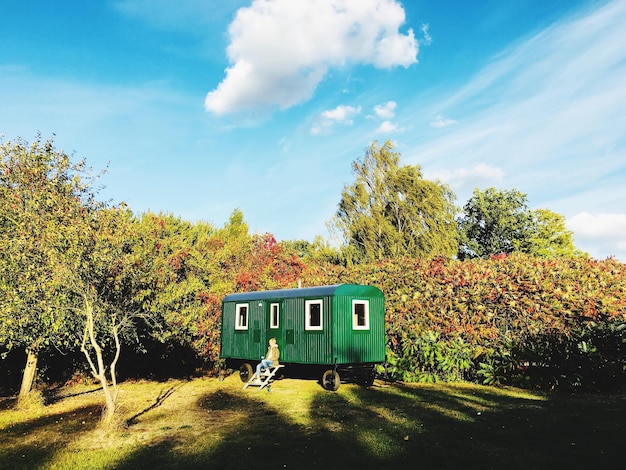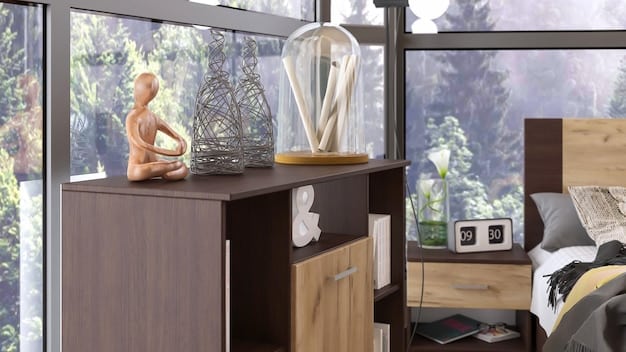Tiny House Subculture: Minimalism & Sustainability in US Housing Revolution

The ‘Tiny House’ subculture in the US is a growing movement driven by minimalism and sustainability, reshaping traditional housing norms with compact, eco-friendly homes.
The ‘Tiny House’ subculture is gaining significant traction in the United States, representing a shift towards simpler, more sustainable living. This movement, fueled by minimalism and environmental consciousness, is changing the way Americans think about homeownership and lifestyle.
The Rise of Tiny Houses in America
The tiny house movement is more than just a fad; it’s a response to economic realities, environmental concerns, and a desire for a more meaningful life. As housing costs continue to rise, and environmental awareness grows, tiny houses offer an appealing alternative to traditional homes.
This section explores the various factors contributing to the popularity of tiny houses in America, highlighting their benefits and the demographic groups most drawn to this lifestyle.
Economic Factors Driving the Trend
The allure of financial freedom is a significant driver for many individuals choosing to embrace the tiny house lifestyle. Lower mortgage payments, reduced property taxes, and minimized utility bills contribute to long-term savings.
Environmental Consciousness and Sustainability
Many advocates believe that living in a tiny house reduces their carbon footprint, conserves resources, and encourages a more eco-friendly lifestyle. The use of sustainable materials and energy-efficient appliances further enhances this appeal.
- Reduced Environmental Impact: Smaller homes require less energy for heating and cooling, minimizing carbon emissions.
- Sustainable Materials: Many tiny houses are built using recycled or sustainably sourced materials.
- Minimalist Lifestyle: Encourages a focus on needs over wants, reducing overall consumption.
The rise of tiny houses in America reflects a growing desire for financial prudence, environmental responsibility, and a more simplified way of life, making it a compelling option for individuals and families alike.
Minimalism as a Core Value
Minimalism is at the heart of the tiny house subculture. It’s about intentionally living with less, focusing on experiences and relationships rather than material possessions. This section delves into how minimalism shapes the design, functionality, and lifestyle associated with tiny houses.
Understanding this connection is crucial for appreciating the full scope of the movement. It goes beyond mere practicality; it’s a philosophical shift toward valuing simplicity and purpose.

Minimalist principles extend beyond the physical space of the home, influencing purchasing habits, consumption patterns, and overall lifestyle choices. The process of downsizing and decluttering becomes transformative, leading to a greater sense of freedom.
Individuals are forced to confront their relationship with material possessions, prioritizing experiences and relationships over accumulating more stuff. This shift can lead to a more fulfilling and intentional life.
- Intentional Living: Consciously choosing to own only what is necessary and beneficial.
- Reduced Consumption: Minimizing the acquisition of unnecessary goods.
- Focus on Experiences: Prioritizing travel, hobbies, and relationships over material wealth.
Minimalism and tiny houses are intertwined not just in design but in the philosophical shift toward a simpler, more intentional lifestyle. This focus on what truly matters enhances well-being and aligns with a more sustainable way of living.
Sustainability and Eco-Friendly Designs
Sustainability is a key element of the ‘Tiny House’ movement, influencing design and construction. These homes often incorporate features that minimize environmental impact, reduce energy consumption, and promote responsible resource management.
This section explores the various eco-friendly aspects of tiny house design and construction, emphasizing how they contribute to a more sustainable lifestyle.
The use of solar panels, composting toilets, and rainwater harvesting systems significantly reduces the environmental footprint of tiny houses. These features enable occupants to live more self-sufficiently and minimize their reliance on conventional utilities.
Furthermore, many tiny houses are built using reclaimed or recycled materials, reducing waste and conserving natural resources. This commitment to sustainability aligns with a broader movement towards environmental stewardship and responsibility.

- Solar Panels: Capturing sunlight and converting it into electricity for powering appliances and lighting.
- Composting Toilets: Reducing water consumption and producing nutrient-rich compost for gardening.
- Rainwater Harvesting: Collecting rainwater for non-potable uses like irrigation and flushing toilets.
By incorporating sustainable practices, tiny houses contribute to a smaller carbon footprint and promote environmental awareness. This commitment to sustainability is a core value of the ‘Tiny House’ subculture, attracting individuals who seek to live in harmony with the environment.
Navigating Legal and Zoning Challenges
One of the biggest hurdles for tiny house enthusiasts is navigating the complex web of legal and zoning regulations. This section explores the challenges faced by tiny house dwellers and the ongoing efforts to advocate for more accommodating policies.
Many municipalities have outdated zoning laws that do not recognize or accommodate tiny houses, leading to uncertainty about where they can legally be parked or built. This lack of clarity can be frustrating for those seeking to embrace the tiny house lifestyle.
Advocates are working to educate lawmakers and zoning officials about the benefits of tiny houses and the need for more flexible regulations. Some communities are beginning to adopt specific ordinances that allow for and regulate tiny houses as accessory dwelling units or within designated tiny house communities.
Understanding Existing Zoning Laws
Navigating local zoning regulations can be complex, as many jurisdictions have minimum square footage requirements for dwellings that tiny houses do not meet. Understanding these regulations is crucial before investing in a tiny house.
Advocacy and Policy Changes
Groups and organizations are working to promote awareness and advocate for policy changes that would make it easier to live in tiny houses legally. They often present tiny houses as a viable solution to affordable housing shortages.
Addressing these challenges is crucial for the continued growth and acceptance of the movement. Overcoming these barriers will encourage more people to consider tiny houses as a viable and sustainable housing option.
Building or Buying: Options and Considerations
The path to tiny house ownership can take several forms. Individuals can choose to build their own tiny house from scratch, purchase a pre-built model from a builder, or even hire a contractor to customize a design. Each option has its own set of considerations.
Building a tiny house offers the most control over the design, materials, and functionality, but requires significant time, skill, and effort. Purchasing a pre-built model can be a quicker and less stressful route, but may come with less flexibility in customization.
This section explores the various options available to aspiring tiny house owners, providing insights into the costs, challenges, and benefits of each approach.
- DIY Build: Offers complete customization but requires significant time and construction skills.
- Pre-Built: Faster and less stressful, but may offer less customization.
- Custom Build: Combines the benefits of both, allowing for tailored design with professional construction.
The decision of whether to build or buy a tiny house depends on individual skills, budget, and time constraints. Weighing the options carefully is crucial for ensuring a successful transition to the tiny house lifestyle.
Community and Shared Experiences
The tiny house movement is not just about individual homes; it’s also about community and shared experiences. Tiny house communities are emerging across the country, offering residents a sense of belonging and mutual support.
These communities provide opportunities for individuals to share resources, exchange ideas, and support each other in their minimalist and sustainable lifestyles. They often feature shared amenities like community gardens, workshops, and recreational spaces.
This section examines the role of community in the ‘Tiny House’ subculture, highlighting the benefits of shared living spaces and the sense of camaraderie that develops among residents.
Benefits of Tiny House Communities
Living in a tiny house community provides access to shared resources and reduces the costs associated with individual ownership. It also fosters a sense of community and mutual support.
The Rise of Co-housing Projects
Inspired by the co-housing movement, some tiny house communities are consciously designed to promote social interaction and collaboration among residents. This approach fosters stronger community bonds and enhances quality of life.
Community and shared experiences are integral to the tiny house movement. They provide support, reduce isolation, and enhance the overall quality of life for those who choose to embrace this alternative lifestyle.
| Key Concept | Brief Description |
|---|---|
| 🏠 + Minimalism | Living with fewer possessions, focusing on experiences. |
| ♻️ + Sustainability | Eco-friendly materials, energy efficiency, reduced footprint. |
| 💰 + Financial Freedom | Lower costs, reduced debt, economic flexibility. |
| 🤝 + Community | Shared experiences, mutual support in tiny house communities. |
Frequently Asked Questions
Generally, a tiny house is defined as a dwelling under 400 square feet, often built on a trailer for mobility. They emphasize simplicity, resourcefulness, and efficient use of space.
No, the legality of tiny houses varies significantly by location. Many areas still have zoning laws that don’t accommodate them, requiring careful research of local regulations.
Costs can range widely, from $20,000 to $80,000 or more, depending on materials, size, and whether you build it yourself or hire a builder. DIY projects are often more affordable.
Advantages include reduced living costs, a smaller environmental footprint, greater financial freedom, and the opportunity to live more intentionally with less clutter.
Tiny house communities are emerging across the US. Online directories and tiny house advocacy groups can provide information on locations and resources for finding these communities.
Conclusion
The ‘Tiny House’ subculture is transforming notions about homeownership and lifestyle in the United States. Driven by minimalism, sustainability, and a desire for economic freedom, the movement reflects a growing awareness of environmental and social responsibility, presenting a compelling alternative to traditional housing.





